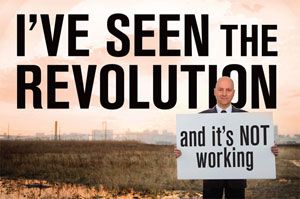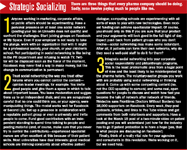I've Seen The Revolution and It's Not Working
Agency Insider Mark Chattaway infiltrates the world of online social media. His consensus: Advertising on social networks is iffy at best
Three years ago, I would have told you that the future lay in personalized news and ever-more sophisticated Web searches. Tell the New York Times that you are interested in breast cancer and it will flag every article published on the subject; list it as a Google Alert and you will soon read more than the average practising oncologist (or you may be an unusually diligent oncologist).

We, in the agency world, were quite comfortable with this because news services still need content and they have to fund themselves through advertising. Google discovers and aggregates content, but it still takes its users to content provided by news services or to Web sites, adding its own targeted advertising along the way.
Content needs PR agencies, Web sites need ad agencies, and advertising obviously needs a funky pool table, a swish office, and an expense account. So, search and aggregation is still a big part of the future.
What we all underestimated, however, was the human instinct to be part of the herd and to follow the crowd.
Searching Google is a very individual pursuit: its algorithms try to take into account how many people look at each site and who links to each page, but the decision on what you click and what you believe is yours alone.
That is not, though, the way most people previously did things. We relied on what our neighbors thought, what the minister said, what Walter Cronkite judged important, or what the local newspaper thought fit to print. Twenty-first century people, on the other hand, worry that the minister is just interested in their tax-free donations. They don't know their neighbors. Only the older ones watch nice, young Katy Couric or read the local newspaper, if there is still one. Most modern people follow the pack through Facebook, Friendster, LinkedIn Connections, or Twitter Followers.
Social animals online
It all started in 2002 with music fans and college students who wanted to find ways of staying in touch with an extended network of friends and of sharing content with one another. Six years later, Facebook has moved from a few hundred Harvard students to having almost 200 million active users—70 percent outside the US; My Space has 76 million in the US alone; and the original social networking site, Friendster, has over 90 million members—about 80 million of them in Asia.
Music fans (and high school dropouts) are more likely to be on My Space; teenagers are more likely to be on Bebo; while college students are still likely to be on Facebook, but the profiles are changing fast.
For the big sites, the fastest-growing demographic is over 35. Those are, of course, your target patients or their children.
Over 18 billion minutes a day are spent on Facebook—10 or 20 of them by my 78-year old mother, who has just got ten key tips on her forthcoming hip replacement from her Facebook friends and will, I imagine, chronicle her physiotherapy—stretch by stretch—on Twitter.
There are not that many other 78-year-olds on Twitter, but the median age of its users is already 31 and climbing rapidly. Those users are attracted by its simplicity: they post messages ('tweets") under 140 characters long. If they are compelling tweeters, they attract followers who opt to receive their messages. Most tweets are stunningly banal; some are news-breaking ("holy f***ing s*** I was just in a plane crash," is how the story of the Continental crash in Denver broke); and some are really important to us ("new insulin device amazing—no one noticed me using it").
Because most tweets are sent from mobile phones, they are often followed by grainy images of the moment in question (the plane crash survivor had one up within minutes of scrambling free of the wreckage).

Strategic Socializing
Companies tweet a lot. Twitter itself aspires to replace a large chunk of the market research industry. Sony tweets Play Station users. AstraZeneca tweets people in the US (mostly with links to corporate press releases, apparently—a real loss for those of us outside North America). Boehringer Ingelheim tweets clinical trial results, but no one yet really tweets patients.
Facebook is a bit more complicated for its users and probably impossible for most pharma companies.
The average user has about 130 "friends" who they have invited to get news about what they are doing, thinking, reading, watching, or worrying about. Any friend can send you material publicly or privately. And while Facebook has now made it possible to maintain several different profiles, it still throws up surprises nonetheless. For instance, I had to think: What would my clients at big liberal foundations make of the friends from my days as a fraternity rush chairman in Alabama—the friends who have an annoying habit of identifying me in incriminating pictures from the 1970s?
Jeff Jarvis, a professor at City University of New York, says we will all soon reach "mutually assured humiliation" (or MAH) and learn to be more tolerant of one another's foibles; others think that the Gotcha! culture will spread from celebrity magazines to real life.
Still, some heavyweight world figures are ready to risk MAH. HM Queen Rania of Jordan has over 12,000 supporters on Facebook—for every snide remark, there are a hundred like this, "u r the best of the best in the world.... i love u my Queen."
Then again, what about pharma companies? Are they ready for an age of MAH?
Pharma friendless on Facebook
Most Facebook content is generated by users or modified by them. The researchers I know on Facebook often make unguarded comments about the data they have seen or the pet theories they are developing. When a senior pharma industry executive who works in New Jersey sent a status update that he was in Ethiopia for a project, I made a point of finding out why.
Some institutions do well on Facebook: I am one of 308 members of the Council on Foreign Relations group and one of about 1,000 of a media group run by the British paper The Guardian. But neither the CFR nor The Guardian is patrolled by corporate lawyers and both groups thrive on lively discussions.
Johnson & Johnson subtly gets around this by using My Space for a nice safe contest focused on its body care brands, but does not talk about oral contraceptives.
But for now, at least, you don't have the option of being too straight-laced and corporate.
Patients have lots of friends
With or without pharma, health groups are growing fast on Facebook. Danielle from Dallas told the global Asthma Awareness group on the day I am writing this, "Xolair rocks. I took it for two years, while my ins covered it, and I was sick maybe 2 or 3 times a year while on it. I have been off for 3 years due to the expense and I get sick once every couple of months while I am off it." Dani from Hawaii added her Xolair experience, "my doctor automatically prescribed an epi pen for me and went over its use, mainly for the first 24 hours after your first few injections. I had absolutely no problems. I was very worried like yourself. I am on several medications for asthma too. I take a lot of prednisone. I take Advair 500/50 twice a day."
Imagine if an asthma company had had any link to the conversation. The lawyers would be calling for the intravenous diazepam, not the epi pen.
An ad agency executive speaking to an industry blogger recently noted mournfully, "corporates don't get many friends on Facebook."
Where's the payoff?
The more the recession takes hold, the more time at home people have and the more they invest that time in a range of media. In part it's because social support has always been a way through hard times; in part it is because staying top of mind means you are most likely to get that posting or e-mail about a job that has become available or a program that can help you.
But even with social networks as a point of entry to blogs (via links to expanded content), the founder of Facebook recently said that social networking sites could not be "monetized" in the same way that search sites had been.
Out of jargon, he meant that advertising on social networking sites has a very mixed track record.
On the one hand, the sites know a vast amount about their users and can target ads extraordinarily accurately; on the other, few advertisers are nimble enough to take advantage of this. Social networking users rarely click through to corporate sites and, when they do, they don't stay for long. Because they are not searching (and because Facebook charges differently), the Google click-through model doesn't work.
Usually to win users over, you have to do something bold that suits social networking. British rugby player Ben Cohen, for example, attracted a vast gay Facebook following by posting nearly nude photos of himself on his fan page (he's happily heterosexual with two children, by the way)—users rapidly discovered them and referred other users.
Nike found that the Nike Shoes page on Facebook had become a hit all by itself so they teamed up with it to offer money-off coupons for users who referred friends—they now have almost two million fans. The Samsung Omnia has 100,000, very sad people who have signed up to talk about features on their phone. It has done wonders for sales of Cohen's calendar, for Nike's recession busting, and for Samsung's geek chic, but it is difficult to imagine Andrew Witty being a major hit in the nude or two million people posting pictures of themselves popping Losec.
By now it is no doubt apparent why this frightens all of us who work in consultancy and in agencies as much as it probably frightens you in the industry.
Social media content is nearly all user-generated, and none of us have figured out how to make real money out of it. I write the occasional reports for clients that back up the theory in this article with facts and examples; sometimes I even run a board training or a senior management planning session. While agencies may have been responsible for some of the clever online ideas, it is nothing like as profitable as the work that we have all relied on for years.
We consultants encourage ourselves: Social networking requires a strategy and Facebook groups need to be fueled by viral videos and neat ideas. There are always the ads that a few users will click on. However, that will not pay for a Mad Men lifestyle—it probably won't even pay for the Series 2 Blu Ray discs.
For Adidas or Honda, the obvious route is to get involved in user-generated content. It means relaxing a few corporate standards and being a bit less obsessive about brand values, but it's doable.
For pharma, it is inconceivable. To make life more difficult, FDA appears to be becoming more restrictive (it has objected to some advertisements on Google search pages—see the following article), and European reforms that would permit more online DTC communication appear stalled by furious opposition from consumerist groups.
Mark Chataway is co-chairman of Baird's Communication Management Consultants. He can be reached at mark.chataway@bairdscmc.com

The Misinformation Maze: Navigating Public Health in the Digital Age
March 11th 2025Jennifer Butler, chief commercial officer of Pleio, discusses misinformation's threat to public health, where patients are turning for trustworthy health information, the industry's pivot to peer-to-patient strategies to educate patients, and more.
Navigating Distrust: Pharma in the Age of Social Media
February 18th 2025Ian Baer, Founder and CEO of Sooth, discusses how the growing distrust in social media will impact industry marketing strategies and the relationships between pharmaceutical companies and the patients they aim to serve. He also explains dark social, how to combat misinformation, closing the trust gap, and more.